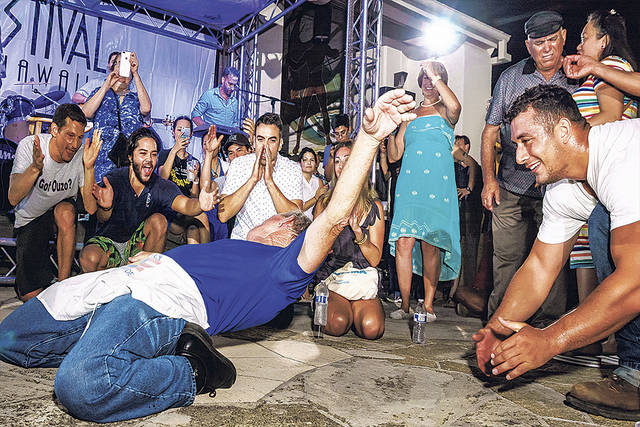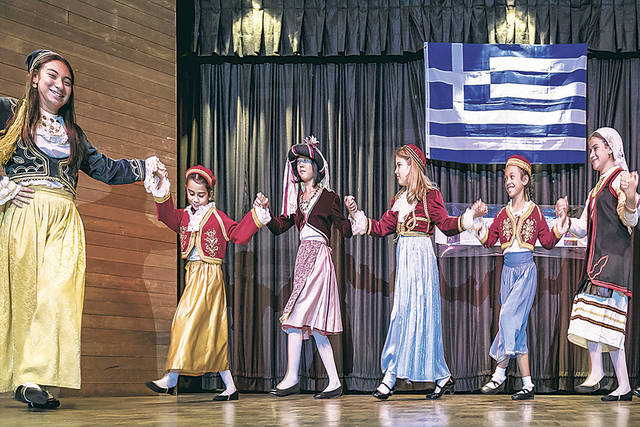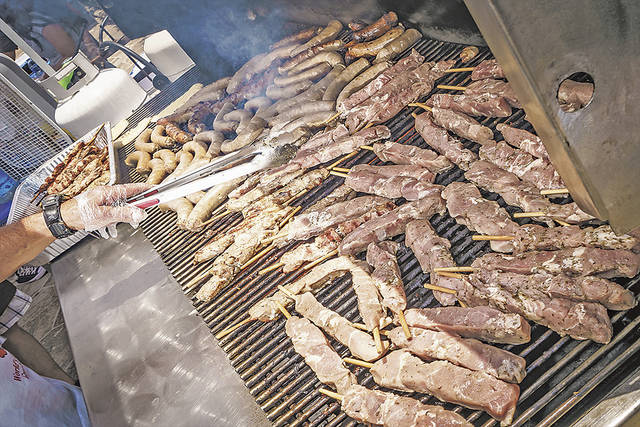Opa! Festival provides a heady dose of Greek culture

COURTESY ROSS HAMAMURA
Freestyle Greek dancing is likely to be on display at the Greek Festival this weekend.

COURTESY ROSS HAMAMURA
Saints Constantine and Helen Greek Orthodox Cathedral of the Pacific has three dance groups, organized by age. Members of Nisiopeda, the youngest group, above, join hands.

COURTESY ROSS HAMAMURA
On the grill are loukaniko (pork sausages) and pork souvlaki (kebabs) marinated in lemon, oregano, olive oil, salt, pepper, onion and garlic.



The Greek Festival started as a fundraiser for Honolulu’s first Greek Orthodox church, now known as Saints Constantine and Helen Greek Orthodox Cathedral of the Pacific. Members of the congregation sold pastries and moussaka (meat and eggplant casserole) at a house on Old Pali Road in Nuuanu, where the church initially held its services.
Thirty-seven years later, the event is one of Hawaii’s largest ethnic celebrations, drawing some 16,000 people to McCoy Pavilion annually to enjoy Greek food, crafts, entertainment and cultural displays. It is not a sedate party; in typical Greek fashion, the mood is carefree and lively, and you’ll likely see more people dancing beside the ponds and banyans at the pavilion than scheduled performers on the stage.
Saints Constantine and Helen’s small congregation of 70 families oversees everything for the two-day festival, from preparing the food to organizing the program to setting up the booths.
This year, you’ll be able to view a multimedia presentation on holy places in Greece, including Mount Athos, a UNESCO World Heritage Site. Closed to women and children, the “Holy Mountain” has been an Orthodox spiritual center since the 10th century and is noteworthy for the priceless murals, manuscripts, embroideries and religious icons in its 20 monasteries.
IF YOU GO: GREEK FESTIVAL
>> Where: McCoy Pavilion, Ala Moana Beach Park
>> When: noon to 9 p.m. Aug. 25 & 26
>> Admission: $3 ($1 if you wear a toga); free for children under 11 and active military personnel and their families
>> Phone: 521-7220
>> Email: info@greekfestivalhawaii.com
>> On the Net: greekfestivalhawaii.com
Proceeds from the Greek Festival support Saints Constantine and Helen’s choir, dance groups, charity projects, Greek language school and youth summer camp in California, which includes instruction in Greek language, traditions and history.
Don't miss out on what's happening!
Stay in touch with breaking news, as it happens, conveniently in your email inbox. It's FREE!
The first Greeks in Hawaii were sailors who arrived on whaling and trading vessels around 1830. More of their countrymen followed and settled in the islands, making a living by running bars, farms, cafes and rooming houses.
“The local Greek population may not be large, but we have a clear presence, especially come festival time,” said Austin Vali, who’s in charge of publicity and entertainment. “Our festival’s goal is to introduce Greek culture to those who aren’t familiar with it and to perpetuate it in Hawaii.”
Vali’s father was born in Greece, and his mother was born in America to Greek immigrants. He grew up in Westchester County, 35 miles north of New York City, where there was a big Greek community. His relatives lived nearby, so there were frequent family get-togethers, always with an abundance of delicious food. Among his favorite childhood memories is lamb cooking on a rotisserie over an open fire; everyone, even the kids, got a chance to turn the spit.
At the Greek Festival, you can savor moussaka, gyro sandwiches, loukaniko (pork sausage), spanakopita (spinach pie), souvlaki (shish kebabs) and dolmathes (grape leaves stuffed with rice). The enticing assortment of sweets includes baklava; kataifi, shredded wheat-like pastries filled with nuts and glazed with honey syrup; kourambiedes, butter cookies cloaked in powdered sugar and filled with almonds and a touch of brandy, gin and vanilla; and melomakarona, cookies made with syrup flavored with honey, oranges, cinnamon, cloves and nutmeg.
“Greeks appreciate good food, and yiayias (grandmothers) have their own set way of doing things,” Vali said. “I remember walking by a booth one year that had a really long line. I went over to see what was going on and found two elderly ladies arguing about the proper way to prepare a dish. Nothing was being cooked; the onlookers were just mesmerized by their animated verbal exchange, which was all in Greek.”
Every year, at least one new menu item is introduced; if it’s a hit, it stays. Making its debut this year will be the Santorini Sundae — vanilla ice cream layered with crumbled baklava.
Beer, wine and ouzo (a dry, anise-flavored liqueur) from Greece will also be available for sale. Reserve time for browsing in the market, which will be stocked with imported foods such as Kalamata olives, feta and kasseri cheeses, taramasalata (creamy cod roe dip) and halvah (fudge-like candy made with sesame paste).
Home chefs who want to expand their repertoire will want to get a copy of “Classic Cuisine: Greek Festival Recipes,” a $5 booklet featuring 19 favorites from Saints Constantine and Helen’s members.
Interestingly, the first cookbook was written around 350 B.C. by Archestratus, a Greek poet and philosopher who had a penchant for fine food. And that tall white hat that professional chefs wear today? It also traces back to Greeks. In the Middle Ages, monks who cooked meals in Greek Orthodox monasteries wore a similar hat to distinguish themselves from their brethren, who wore large black hats.
In addition to food, music is an important part of Greek life; it brightens every occasion, be it a wedding, baptism, birthday, religious observance or impromptu gathering of friends and family.
According to Vali, Greeks have a special connection with music, whether or not they have been formally trained. Key to that bond is kefi, which can’t be completely translated in English; the closest meaning is “a joyful spirit.”
“When Greeks sing, dance and play music, you know they have kefi and their hearts are in it,” Vali said. “Their joie de vivre is infectious; even if you’re normally shy, you’ll find yourself dancing next to strangers and shouting ‘Opa!’ — a happy, uplifting expression that reminds us it’s great to be alive.”
As usual, Saints Constantine and Helen’s three dance groups are slated to perform. Reflecting the ethnic diversity of the congregation, the Nisiotes Dancers (adults), Nisiotopoula Dancers (youths) and Nisiopeda Dancers (little children) are composed of dancers who are Greek, part Greek and not of Greek descent at all.
“Bloodline doesn’t matter,” Vali said. “What binds the groups together is their Orthodox faith and their love of dancing. Their costumes are beautiful — with elaborate beading, embroidery and trims — and after the dancers perform, if anyone in the audience wants to take pictures with them, they’re pleased to oblige.”
In short, the Greek Festival is an enthralling visit to an exotic island destination halfway around the world. “There’s no need for a passport or plane ticket,” Vali said. “Come get an amazing taste of Greece without leaving Hawaii.”
Cheryl Chee Tsutsumi is a Honolulu-based freelance writer whose travel features for the Star-Advertiser have won several Society of American Travel Writers awards.



